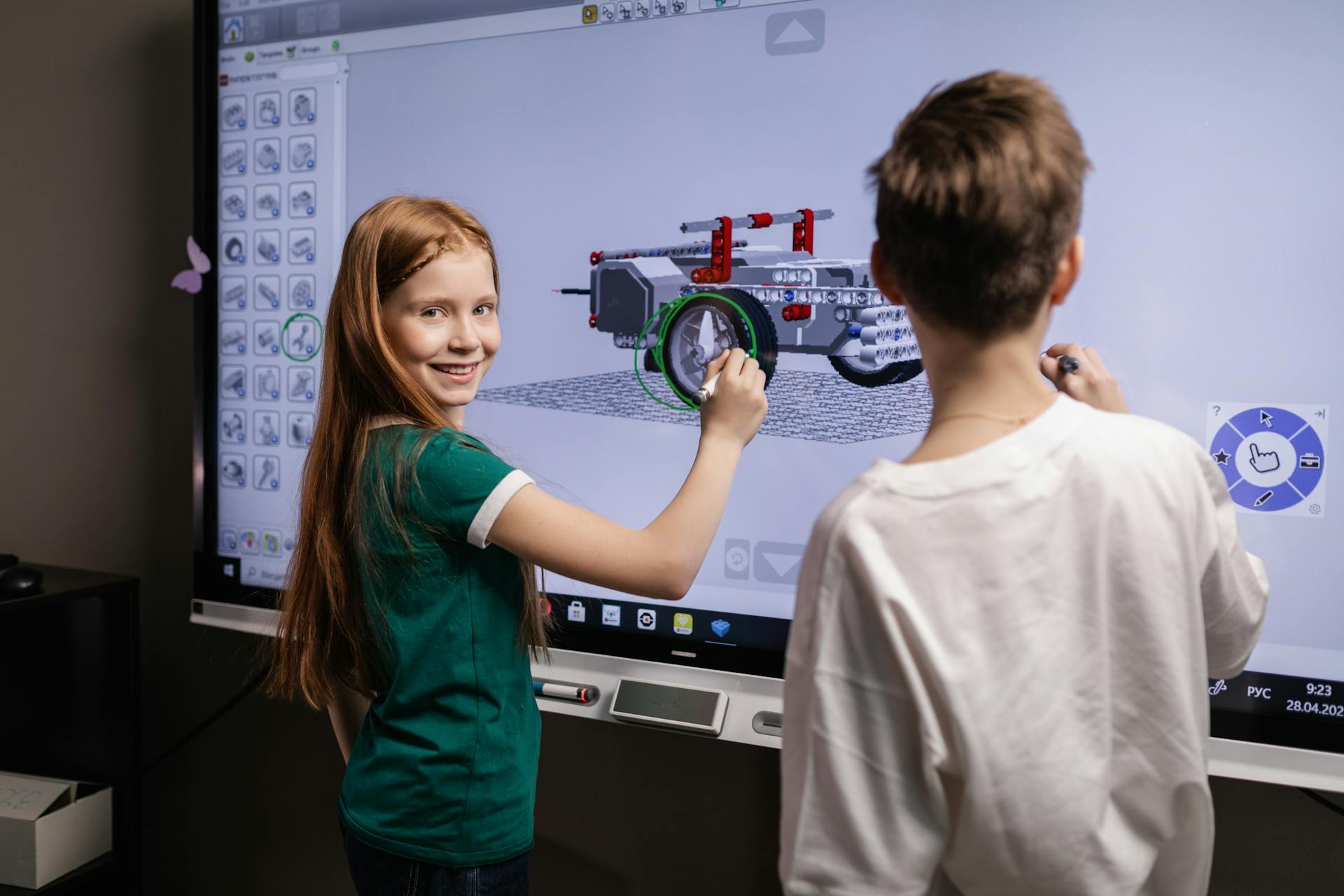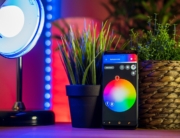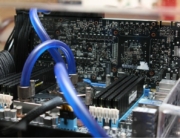Home / Handy Tips /

Schools have historically had a complex relationship with technological integration, with many restrictions like smartphone bans shaping an anti-gadget norm within these institutions.
However, schools and parents are also fully aware that technology can be an indispensable tool in helping support classroom learning.
From various collaborative digital tools to an array of electric instruments to facilitate learning, several tech gears can benefit students and teachers alike.
Let’s touch upon these various tech gear that can enhance your child’s learning in the classroom.
1) Interactive Whiteboard
One of the most important pieces of school equipment is the whiteboard. This instrument serves as the main canvas on which lecturers and teachers write and relay the subject matter to their students.
While the traditional chalkboard or whiteboard does a good job of creating a decent learning experience, an interactive whiteboard elevates the student’s learning potential to the next level.
For one, these boards are highly versatile and customisable. Teachers can display multimedia content, annotate straight on the screen, or encircle and save notes for use in upcoming lectures.
Furthermore, the interactive whiteboard can also connect with other devices like laptops, tablets, and smartphones. This opens up a new world of possibilities, like allowing the playback of online lectures by simply embedding a hyperlink onto the whiteboard.
The reason why children learn better with this tool is that it works faster than traditional writing on a normal board. The reduced time it takes can help them retain their attention.
Furthermore, it also allows the lecturer to pull up a vast array of digital resources from the internet and display them on the board, increasing the odds of making a more engaging lecture that students will pay attention to.
All these factors mashed together create a more engaging, dynamic, and efficient learning environment that’s easy for the teachers to adopt and even easier for the students to learn from.
2) Headphones
Headphones aren’t just for listening to music or immersing oneself in a gaming environment, they’re also an essential tool for learning, especially in modern classrooms.
The reason why they’re so important is because it helps enhance a student’s focus on audio and video-based learning material. This is especially true if they’re doing a task that follows a self-paced approach.
Without headphones, a flurry of sounds can echo throughout the classroom when multiple people play their own files, which can be extremely distracting and hard for students to learn in their most effective way.
As such, students need to be equipped with the best-quality headphones, specifically Sturdy School Headphones. There are various categories of headphones available, each designed to meet specific needs, such as noise-cancelling, soft-cupped, wireless, and even those with built-in microphones.
Schools often have to follow their government’s regulatory procedures regarding school equipment, meaning that whatever headphones your classroom has, are likely to be already vetted to be conducive for learning.
Regardless, knowing that your school has these headphones guarantees two things: your kid can learn audio material in a conducive environment and they won’t worry about disrupting (or being disrupted) by others.
3) Laptops
Another essential technological hardware that every student should have in their possession is a laptop.
This portable computer is something that almost every older student needs to have to access reading material, conduct research, take notes, collaborate with group projects, and perform other tasks and assignments in the digital realm.
Not all schools will provide laptops, so it’s important to browse through student-friendly options and consider some important factors before buying them, such as size, RAM, CPU performance, and storage size.
Teachers should also be equipped with a laptop, as this tool allows them to connect to display ports within the classroom setting to help facilitate lectures and create a more engaging classroom environment.
Furthermore, with the advent of online learning and remote classes, a laptop ensures that your child is also prepared in case physical classes are called off.
They’re often a much better choice than smartphones as they have bigger displays, peripheral connectivity, and easier navigation for software like Microsoft Office.
4) Document Cameras
Handling a class of tens of students can be difficult, especially if you’re in a big classroom like a lab setting.
This is especially true if you’re trying to hold a lecture about a specific, tangible object that’s meant to be distributed and passed around to each student, like a document or a Petri dish sample.
Instead of doing that, however, you can use a tool called a document camera to shoot an image from a built-in camera that gets projected onto a flat surface, like a whiteboard in real time.
The camera can be zoomed in and out and can take on multiple different angles, making it a fairly flexible tool for detailed image projecting.
The projection is also big, allowing your students to simultaneously and clearly see the object no matter where they’re situated. This makes for a more efficient and easy-to-follow item presentation.
Besides that, document cameras also come with the added perk of recording and storing past showcases. This can be turned into a file and distributed to students later, which can help them retain the information more easily.
5) Tablets
Another important piece of technology that students should have is a tablet. Unlike a laptop, tablets offer greater portability and ease of use thanks to its lightweight build and touchscreen features.
Furthermore, these devices allow students to access a new intuitive and interactive ecosystem with the presence of applications and games that may not be available in computer-based hardware.
For instance, tablets make it easy for students to perform school-related tasks in a quick and user-friendly manner, like taking notes and making designs.
Tablets also offer the same wealth of information that computers can provide thanks to their ability to connect to the internet. Just in a more compact, portable, and lightweight form.
There are also accessories that can enhance the tablet experience, such as tablet stands, external keyboards, mice, and customisable cases for added protection.
With all that said, this tool is a great one to have for students who want to enhance their learning environment in school—and if the school has the budget for it, it should be something every student should have throughout the school year.
6) Digital Textbooks
Another tech tool that’s been making waves in the school environment is a digital textbook. This textbook substitutes traditional paper-based textbooks with interactive, digital screens that can be accessed through e-readers.
These textbooks are beneficial for a number of reasons.
For one, it cuts down the need to use printed books, lowering the demand for carbon-negative, unsustainable practices. Secondly, it can access a wide range of textbooks, making it a highly versatile piece of equipment that can be used across classes. Third, it also comes with features to enhance reading quality of life, like font size changes, brightness settings, and more.
Moreover, schools and students can also lower overall costs by renting digital textbooks for a short time. This can help keep student and school budgets at reasonable levels, all while providing access to a piece of technology that has an upper hand over print media.
7) Projectors
Not all classrooms need to be equipped with the latest, state-of-the-art technology—and that’s okay. You can’t go wrong with the basics, and a traditional projector is something that every classroom can benefit from immensely.
Projectors are must-haves for classrooms that don’t have interactive boards or document cameras since they allow teachers or students to display visual material in the front of the class. This can be anything from a video, a slideshow, or an interactive lesson.
Most projectors require wired connectivity, but a lot of modern ones are starting to transition to wireless connectivity options. As much as possible, it’s ideal for classrooms to have high-definition projectors to ensure that every student can see what’s displayed.
A projector opens up a new world of teaching and education, which can help students learn better and access a more digitised form of education.








Leave A Comment